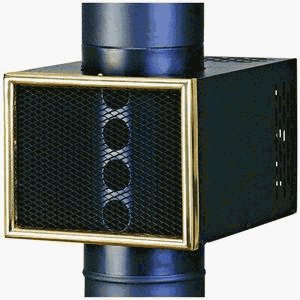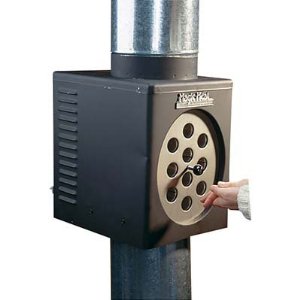
Stove pipe fans
 Our original plan for getting
heat out of the wood stove
alcove included one
of those nifty stove pipe fans, which are designed to turn on when the
stove pipe heats up, blowing the hot air into the room. You can
find a couple of different kinds on the internet, where they go by
names ranging from "Magic Heat Reclaimer" to the more simple "Stove
Pipe Heat Reclaimer" and cost anywhere from $100 to nearly $200.
Our original plan for getting
heat out of the wood stove
alcove included one
of those nifty stove pipe fans, which are designed to turn on when the
stove pipe heats up, blowing the hot air into the room. You can
find a couple of different kinds on the internet, where they go by
names ranging from "Magic Heat Reclaimer" to the more simple "Stove
Pipe Heat Reclaimer" and cost anywhere from $100 to nearly $200.
However, after some
online research and then looking at the real fan in the store, we
decided against the stove pipe fan. The model sold at Tractor
Supply says right on the box that it's not suitable for use with an
efficient stove, and various reviews on the internet note that the fan
reduces the stove's draft and causes excessive creosote buildup in the
pipe. In addition --- and here we admit to being a bit lazy ---
the fan doesn't wrap around an existing pipe the way we thought it
would. Instead, you have to take apart your chimney, cut the
stove pipe sections to size, and then install the fan as one of the
pipe sections. Since we
went to a lot of trouble to get our stove pipe straight and beautiful
with no cutting,
we're not willing to take it back apart to install a fan that looks
like it would make our stove work improperly.
 There do seem to be a few
applications where the stove pipe heat reclaimers make sense, so I
thought I'd post in case some of you were considering a similar
purchase. If you're burning coal, you might be okay --- the
higher heat fires and lack of creosote in the smoke delete some of the
potential pitfalls of the stove pipe fan. Also, if you're running
a really inefficient stove, you're probably sending a lot of heat up
the chimney pipe and might want to try to reclaim it even if the fan
messes with other parts of your stove. For our own application,
though, Mark's on the prowl for a small, metal-bladed fan that he can
mount on the front ceiling of the alcove to do the same job for less
cash and no impact on our princess's job performance.
There do seem to be a few
applications where the stove pipe heat reclaimers make sense, so I
thought I'd post in case some of you were considering a similar
purchase. If you're burning coal, you might be okay --- the
higher heat fires and lack of creosote in the smoke delete some of the
potential pitfalls of the stove pipe fan. Also, if you're running
a really inefficient stove, you're probably sending a lot of heat up
the chimney pipe and might want to try to reclaim it even if the fan
messes with other parts of your stove. For our own application,
though, Mark's on the prowl for a small, metal-bladed fan that he can
mount on the front ceiling of the alcove to do the same job for less
cash and no impact on our princess's job performance.
Want more in-depth information? Browse through our books.
Or explore more posts by date or by subject.
About us: Anna Hess and Mark Hamilton spent over a decade living self-sufficiently in the mountains of Virginia before moving north to start over from scratch in the foothills of Ohio. They've experimented with permaculture, no-till gardening, trailersteading, home-based microbusinesses and much more, writing about their adventures in both blogs and books.
Want to be notified when new comments are posted on this page? Click on the RSS button after you add a comment to subscribe to the comment feed, or simply check the box beside "email replies to me" while writing your comment.

You can get vane axial fans like the ones used in electrical and electronic panels that run on very little electricity. Some are metal, most are thermal plastic and come in many sizes. For your use, one of 4 to 6 inches mounted at or near the ceiling would be more than enough to move the heated air in that space, out into your living space. You can run them off a thermostat or just turn them on and off as desired. You can get them at any electric outlet or radio shack and they don't cost much.
Another idea is to take a regular box fan and have it blow into the space while sitting on the floor. It is a bit inconvenient for efficient use of space but it works and moves more air. Slow speed would be more than enough.
This is the fan I'm thinking of at the moment.
The Ace hardware website calls it a 12 inch Retro table fan.
It oscillates, it's metal, and it cost 40 bucks.
I've got a few different thoughts on how to mount it.
Instead of looking at heating the air, look at how to get the IR radiation out of the alcove.
Generally radiant heat does more for comfort than heating the air, especially if you can get the walls to warm up. Besides, air is a very poor transport medium for heat.
I've been in a workshop where the air was cold enough that the moisture from your breath condensed. Yet due to a couple of gas-heated radiators it felt fine to work in.
Good ideas, everybody! On the whole, I tend to subscribe to an Asian mindset on heat --- put your heat source in the most used space and focus your more sedentary activities there. The stove does a great job of heating up our main living/dining/kitchen space, and I don't like heat in my bedroom anyway. (Mark has a space heater in the East Wing while we're figuring out another stove for him.) When we work in the office, we have a fan that blows heat down the hall and does quite well.
But we do feel like there's a lot of heat that accumulates in the alcove that we'd like to move just a foot or so out into the main living area. Thus the fan. I think Roland's suggestions on my Cooking on the wood stove post would work great in a more traditional household where you expect to have heat in a much larger area, and don't need to be able to leave home for several days and let the house drop below freezing without causing problems. We like the freedom of leaving the farm in the cold if we want to and not worrying about backup heat for an empty house.
I love Alison's husband's idea of using an old computer fan --- we certainly have a lot of those lying around! Zimmy --- we do have metal on the walls as heat shields, but could maybe use one on the ceiling.